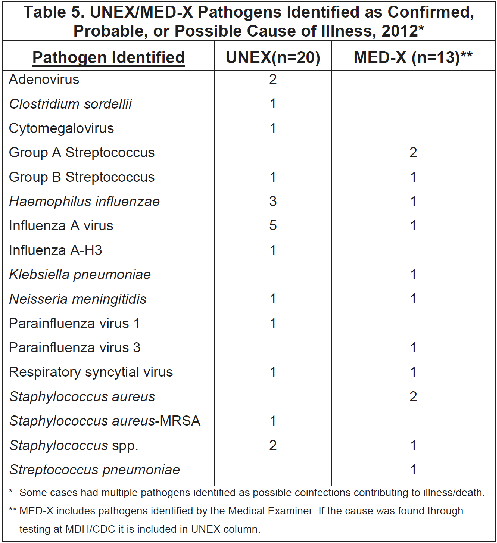Annual Summary of Disease Activity:
Disease Control Newsletter (DCN)
- DCN Home
- Annual Summary, 2022
- Annual Summary, 2021
- Annual Summary, 2020
- Annual Summary, 2019
- Annual Summary, 2018
- Annual Summary, 2017
- Annual Summary, 2016
- Annual Summary, 2015
- Annual Summary, 2014
- Annual Summary, 2013
- Annual Summary, 2012
- Annual Summary, 2011
- Annual Summary, 2010
- Annual Summary, 2009
- Annual Summary, 2008
- Annual Summary, 2007
- Annual Summary, 2006
- Annual Summary, 2005
- Annual Summary, 2004
- Annual Summary, 2003
- Annual Summary, 2002
- Annual Summary, 2001
- Annual Summary, 2000
- Annual Summary, 1999
- Annual Summary, 1998
- Annual Summary, 1997
Related Topics
Contact Info
Unexplained Critical Illnesses and Deaths of Possible Infectious Etiology (UNEX) and Medical Examiner Infectious Deaths Surveillance (MED-X), 2012
Surveillance for unexplained critical illnesses and deaths of possible infectious etiology (UNEX) began September 1995. Focus is given to cases <50 years of age with no significant underlying conditions; however, any case should be reported regardless of the patient’s age or underlying medical conditions to determine if further testing conducted or facilitated by MDH may be indicated. In addition to provider reporting, death certificates are reviewed for any deaths in persons <50 years of age with no apparent significant underlying conditions for possible unexplained infectious syndromes.
In 2006, MDH began Medical Examiner (ME) Infectious Deaths Surveillance (known as MED-X) to evaluate all ME cases for infectious-related deaths. MEs report explained and unexplained cases. Unexplained deaths in previously healthy individuals <50 years of age are included regardless of infectious hallmarks; this is predominantly represented by Sudden Unexplained Infant Deaths. In addition, we review death certificates for any case in which an autopsy was performed by an ME with a potential infectious cause of death. Cases found through death certificate review are also considered for UNEX surveillance if they are <50 years of age and have no immunocompromising conditions.
Testing of pre-mortem and post-mortem specimens is conducted at the PHL and the CDC Infectious Diseases Pathology Branch (IDPB). Cases are excluded from UNEX if they are determined to be explained by providers, are not critically ill, or have no infectious disease hallmarks.
There were 82 cases that met criteria for UNEX surveillance (71 deaths and 11 critical illnesses) in 2012, compared to 137 cases in 2011. Of the 82, 59 (72%) were reported by providers, 20 (24%) were found by death certificate review, and 3 (4%) were found through other reporting methods. Forty-nine (60%) cases presented with respiratory symptoms; 10 (12%) with neurologic symptoms; 9 (11%) with cardiac symptoms; 5 (6%) with sudden unexpected death; 3 (4%) with shock/ sepsis; 3 (4%) with an illness that did not fit a defined syndrome; 2 (2%) with gastrointestinal illness; and 1 with a genitourinary illness. The age of cases ranged from newborn to 89 years. The median age was 16 years among 59 reported cases, and 57 years among 20 non-reported cases found through active surveillance. Forty-seven percent resided in the metropolitan area and 47% were male.
There were 284 MED-X cases in 2012; 69 of these also met UNEX criteria. The median age of the cases was 46 years, and 58% were male. There were 158 (56%) cases found through death certificate review. MEs reported 126 (44%) cases. The most common syndrome was pneumonia/upper respiratory infection (n=130 [46%]). Of the 284 cases, 54 (19%) were confirmed to have had an infectious cause, 170 (60%) had possible infectious causes, and 60 (21%) were non-infectious or unknown cause.
There were 135 cases that had specimens tested at the PHL and/ or the IDPB. Thirty-three cases had pathogens identified as confirmed, probable, or possible cause of illness, including 20 UNEX cases (Table 5). Among 40 unexplained deaths occurring in those <50 years of age without any immunocompromising conditions, UNEX helped to identify the pathogen(s) involved in 13 (37%) cases. ME surveillance detected an additional 12 cases with pathogens identified by MEs as the cause of death (Table 5). Cases with pathogens of public health importance detected included a 25 year-old male with a 2-3 day history of fever, cough, and body aches who presented with altered mental status and leukocytosis. During a brief hospitalization he died. CSF PCR testing done at the PHL identified Neisseria meningitidis serogroup B. A contact investigation was conducted to recommend prophylaxis to all close contacts. Three Haemophilus influenzae serotype f cases were identified through ME surveillance, these cases were part of a cluster of Haemophilus influenzae serotype f identified during the first quarter of 2012.

- For up to date information see>> Unexplained Deaths and Critical Illnesses
- Full issue>> Annual Summary of Communicable Diseases Reported to the Minnesota Department of Health, 2012